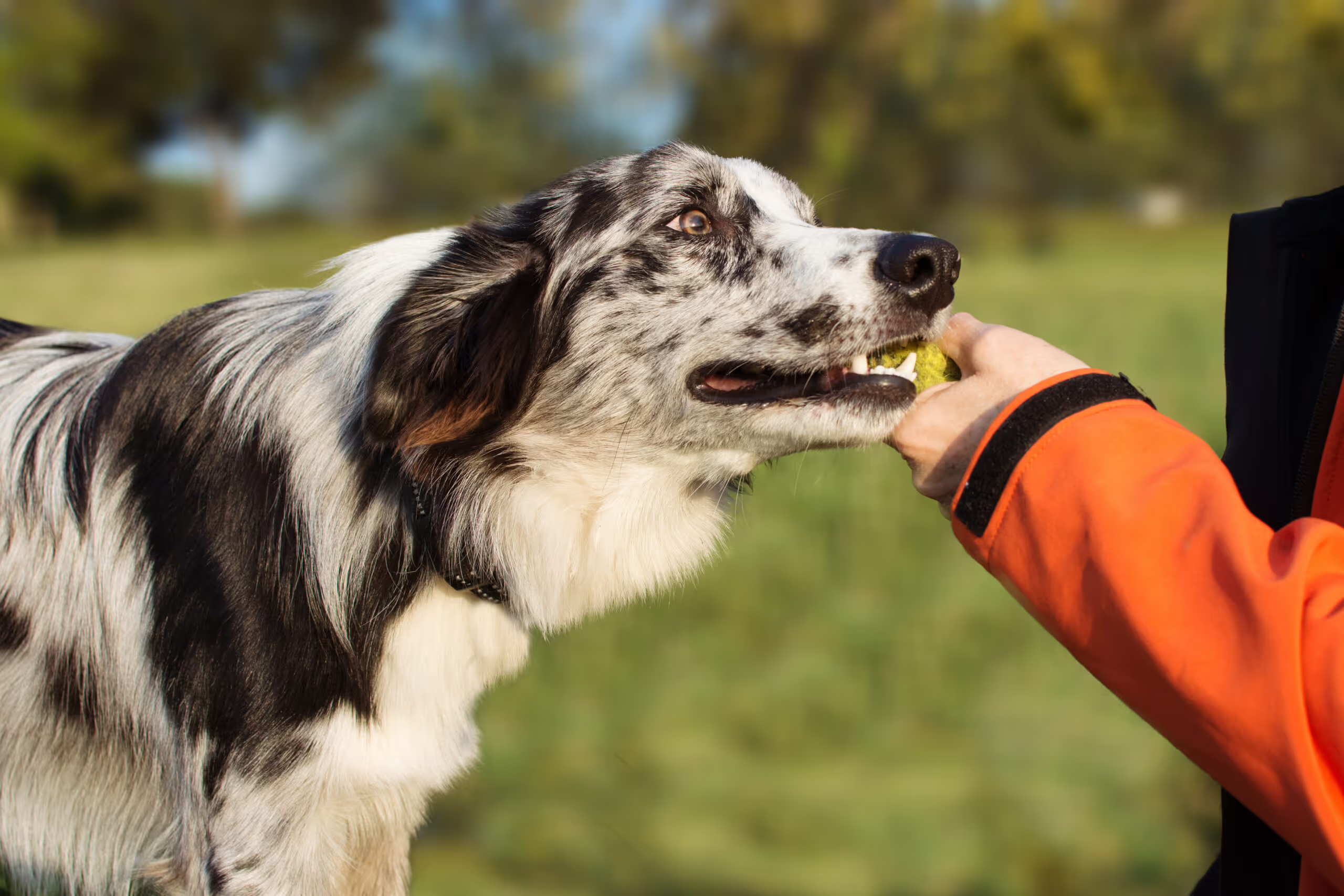For the Purrbabies


Teaching your dog to fetch shouldn’t be an overwhelming challenge. Here are tips for teaching your dog to fetch.
.webp)
Each trick you train your dog to perform, whether it’s “roll over,” “heel,” or “shake,” makes your friend a better companion, strengthens their bond with you, and hopefully, makes you both happier.
But what about fetch? How easy is it to teach your pup to return something on command? Read on to learn how to train your furry friend to fetch with some tried-and-true methods.
For best results when training your dog to fetch, the object you use should be something they find fun and interesting. Try out several different types of toys so you can determine what your dog likes best. For instance, some dogs are ball lovers, while others prefer plush toys.
You know your dog best, so go with your gut and don’t be afraid to try a few options to see what they like the most! In all cases, particularly with rope toys and squeaky toys, make sure that there’s no risk of your dog chewing and swallowing the toy. This can quickly become an emergency situation.

The best treats to train a dog with are small, easy to chew, and tasty (to your dog, at least!). Good examples include plain cooked chicken, cut-up pieces of hot dogs, or super potent treats. Small pieces of high-value treats in short sessions are the best way to keep your dog excited and focused during training.
👉 Give your dog treats in moderation to avoid overfeeding them. This can lead to stomach upset or, over time, obesity.
One of the most important things to remember when training your dog to fetch is to use clear and consistent commands. Here are some basic commands you’ll want to use while teaching your dog to fetch:
Other useful commands to already have in your repertoire include “leave it,” “stay,” and “come.” These basics make teaching more advanced tricks much easier in the long run, as they usually are involved in the commands in some way.

Start training your dog in a small space with little to no distractions and gradually move to larger spaces as they learn to fetch consistently. Doing this will help your dog remain comfortable and focused on the task at hand.
Here are some great places to teach your dog to fetch, starting with smaller areas with few distractions moving up to larger areas with more:
👉 Be sure to check your leash laws in the are before letting Fido loose!
Now that you’re familiar with the different toys, locations, and commands you can use to teach your dog to fetch, you can start the actual training by following the simple steps below.
Choose a toy your dog enjoys playing with. Tease them with it to get their “prey” drive up, play a game of tug-of-war with it, or stuff a treat inside it to build their interest — then reward them when they show it attention.

Start this step in a small space with few distractions, like a hallway.
Throw the toy of choice a short distance away while saying “fetch” and, once your dog grabs ahold of it, call them back to you in an upbeat voice. They’ll get excited and run back, while still holding the toy like you taught them.
As soon as they’re back to you, ask them to “drop it” and give them a treat.
Once your dog is comfortable picking up and returning the toy in this setting, gradually increase the distance you toss the toy by two to three feet at a time. Eventually, you can move to larger spaces, like a large room, a fenced yard, or even a field.
To make the process more fun for your dog, use a variety of toys they love, like balls, plush toys, or ropes. Use treats to motivate your dog and reinforce good behavior, and make sure to shower them with praise and belly rubs each time they bring the toy back to you.
It’s also important to be consistent with your cues and commands. Use the same command every time you throw the toy.
Training sessions should be fun for your dog. Pay attention to their behavior and body language. If they seem to be getting bored, end the training session and try again later.
Remember, dogs have short attention spans and need frequent breaks to stay motivated and engaged. Ending a training session on a positive note — when your dog is still interested — will leave them looking forward to the next session.

Teaching your dog to fetch takes patience. Here are some problems you might encounter and how to solve them.
Bait and switch. If your dog runs away with the toy instead of bringing it back, try the bait-and-switch method. When they pick it up and start running away, show them a second toy and call them back to you. The hope is they’ll be excited about the other toy and want to come back to play with it.
As soon as they drop the first toy, immediately throw the second toy in the opposite direction. This will encourage them to let go of the first toy and chase after the second one. Switch between the two toys until your dog understands that when they bring the toy back to you, they’ll get to play with another toy.
Eventually, you can phase out the second toy and only reward your dog with treats and praise when they bring the original toy back to you.
Run backwards. You can also try the “run backwards” method. As soon as your dog grabs the toy, start moving backwards and call them back in an excited voice. A dog’s natural inclination to chase will take over and they’ll want to run to you since you’re moving away from them.
As soon as they reach you, lots of praise and a treat for bringing the toy back.
Keep them on a leash. In some instances, you may want to use an extra long leash on your dog while you play fetch. When they grab the toy, you can reel them back in instead of letting them run off. As soon as they make it all the way back, you give them a treat and praise for “returning” the toy, even if you guided them along the way.
Eventually, they’ll learn that bringing the toy back leads to yummy treats while running away doesn’t.
If your dog doesn’t respond when you throw the toy, they probably don’t understand what you’re trying to teach them. Try these tips:
👉 Tip: If your dog still seems uninterested in playing fetch, try making the game more exciting by playing a game of chase or playing tug-of-war with the toy before throwing it. This can help get your dog excited and encourage them to participate in the training session.
There are a lot of things that can reduce — or even eliminate — a dog’s desire to play fetch. Poor health, boredom, stress, or distractions are all common reasons.
Health. Some illnesses and conditions, like arthritis, can impact a dog’s physical ability to play. If it hurts to run, they won’t want to chase after a toy anymore. If you notice that your dog seems lethargic or reluctant to play, those issues may be a sign of illness, so it’s best to see a veterinarian.
Boredom. If you’ve played fetch with the same toy repeatedly, your dog may be bored with it. Try switching it up with something new, go to a new location, or change the game entirely.
Stress. A stressed dog doesn’t usually want to play. Changes in their routine, loud noises, or worrisome distractions can definitely lead to an anxious pup, thus leading them not to want to engage with you. Keeping them happy and relaxed throughout their day gives them the energy to play later on.
Distractions. Speaking of distractions, even if they don’t cause your pup any stress, they can certainly be more entertaining than a game of fetch. If you notice your dog having a hard time focusing on you and finding interest in other things, try switching locations to a less distracting spot to re-engage.
Any toy that your dog loves should do the trick. The best toys include tennis balls, soft discs, ropes, and squeaky toys.
Start teaching your dog to return the toy to you in a small space, like a hallway. Toss the toy slightly farther away each time, and give your dog treats and praise each time they do the trick correctly.
Stop while you’re ahead. If you notice your dog getting tired or losing interest, pause the training session and try again later. This will help ensure that the dog’s enthusiasm level stays high.








